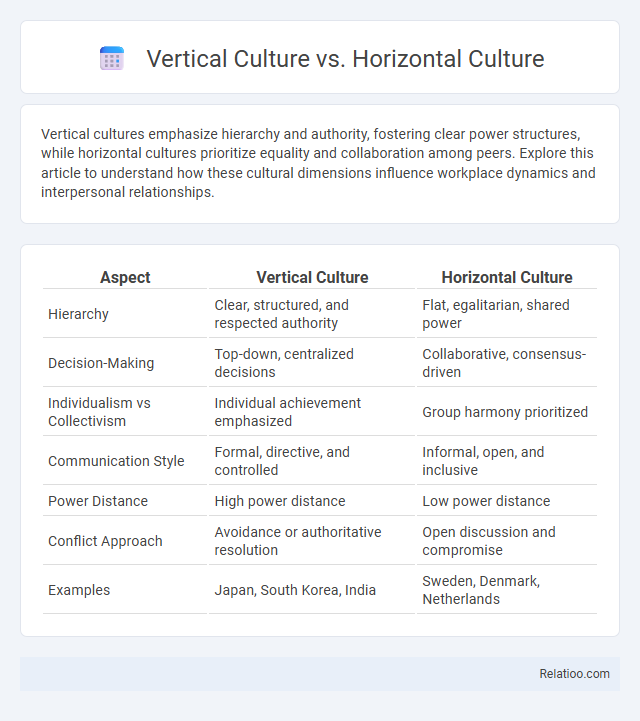Vertical cultures emphasize hierarchy and authority, fostering clear power structures, while horizontal cultures prioritize equality and collaboration among peers. Explore this article to understand how these cultural dimensions influence workplace dynamics and interpersonal relationships.
Table of Comparison
| Aspect | Vertical Culture | Horizontal Culture |
|---|---|---|
| Hierarchy | Clear, structured, and respected authority | Flat, egalitarian, shared power |
| Decision-Making | Top-down, centralized decisions | Collaborative, consensus-driven |
| Individualism vs Collectivism | Individual achievement emphasized | Group harmony prioritized |
| Communication Style | Formal, directive, and controlled | Informal, open, and inclusive |
| Power Distance | High power distance | Low power distance |
| Conflict Approach | Avoidance or authoritative resolution | Open discussion and compromise |
| Examples | Japan, South Korea, India | Sweden, Denmark, Netherlands |
Understanding Vertical and Horizontal Cultures
Vertical culture emphasizes hierarchy, authority, and clear social stratification, where power and status are concentrated at the top levels. Horizontal culture promotes equality, collaboration, and shared decision-making, minimizing social distinctions and encouraging open communication among members. Your comprehension of these cultural frameworks aids in navigating social hierarchy dynamics effectively, especially in diverse organizational or societal contexts.
Key Characteristics of Vertical Cultures
Vertical cultures emphasize hierarchy, authority, and clear power distinctions, with individuals often accepting inequality as a natural social order. In these cultures, roles and responsibilities are well-defined, and decision-making tends to be centralized among leaders or elders. Understanding these key characteristics can help you navigate environments where respect for status and rank is paramount.
Defining Features of Horizontal Cultures
Horizontal cultures emphasize equality, collaboration, and decentralized decision-making, minimizing formal status differences in social hierarchy. Your interactions in such cultures often prioritize open communication and shared responsibility, fostering inclusive environments where individuals are valued equally. This contrasts with vertical and hierarchical cultures where rank and authority distinctly shape relationships and organizational structures.
Power Dynamics in Vertical vs Horizontal Societies
Power dynamics in vertical cultures typically emphasize hierarchical authority, where decision-making flows top-down and social status dictates influence and control. Horizontal cultures promote egalitarian relationships, encouraging collaboration and shared power among members, minimizing rigid status distinctions. Understanding these contrasting structures reveals how organizational behavior, communication styles, and leadership effectiveness vary between societies with vertical or horizontal cultural orientations.
Communication Styles Across Cultural Orientations
Vertical cultures emphasize hierarchical communication where respect for authority and formal language dominate, fostering clear power-distance distinctions. Horizontal cultures promote egalitarian communication with open dialogue and informal interactions, reducing status barriers in conversations. Social hierarchy influences communication styles significantly, as high-ranking individuals often command conversational control in vertical settings, while horizontal cultures encourage equal participation regardless of status.
Social Hierarchy and Status: A Comparative Analysis
Social hierarchy and status significantly influence organizational behavior across vertical and horizontal cultures, shaping power dynamics and decision-making processes. Vertical cultures emphasize clear authority layers and rank-based respect, whereas horizontal cultures promote equality and shared responsibility, minimizing status distinctions. Understanding these differences helps you navigate social hierarchies effectively, enhancing collaboration and leadership strategies.
Implications for Workplace and Leadership Structures
Vertical culture emphasizes hierarchical authority and clear power distances, often resulting in centralized decision-making and formal leadership roles within the workplace. Horizontal culture promotes egalitarian relationships and collaboration, encouraging shared leadership and flatter organizational structures that foster open communication and innovation. Understanding the implications of these cultural dimensions helps leaders tailor management practices to enhance employee engagement, productivity, and effective conflict resolution.
Conflict Resolution Approaches in Both Cultures
Vertical cultures emphasize hierarchical structures where conflict resolution often involves deference to authority and formal mediation by higher-ranking individuals. Horizontal cultures promote egalitarian relationships, encouraging collaborative dialogue and consensus-building to resolve disputes among peers. Understanding social hierarchy dynamics in vertical versus horizontal settings is crucial for tailoring conflict resolution approaches that align with cultural expectations and power distribution.
Adapting Across Cultural Contexts: Strategies and Challenges
Adapting across cultural contexts requires understanding the dynamics of vertical culture, horizontal culture, and social hierarchy to navigate power distances and interpersonal relationships effectively. You can enhance cross-cultural communication by recognizing that vertical cultures emphasize rank and authority, horizontal cultures value equality and collaboration, and social hierarchies dictate formal roles and status. Employing strategies such as cultural awareness, empathy, and flexible communication styles helps overcome challenges like misinterpretation, resistance, and conflicting social norms.
Impact of Culture Type on Personal Relationships
Vertical cultures emphasize status differences and clear social hierarchies, which can create formal and respectful personal relationships but may limit open emotional expression. Horizontal cultures promote equality and minimize status distinctions, fostering closer, more egalitarian relationships where individuals feel more comfortable sharing personal thoughts. Understanding your cultural context helps navigate social dynamics effectively, enhancing communication and trust in both personal and professional settings.

Infographic: Vertical Culture vs Horizontal Culture
 relatioo.com
relatioo.com